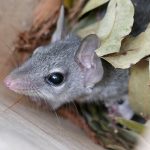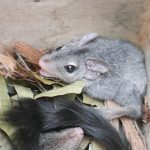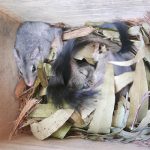BRUSH-TAILED PHASCOGALE
Life in the Treetops
The Brush-tailed Phascogale is a remarkable, tree-dwelling marsupial carnivore belonging to the family Dasyuridae. Instantly recognisable by its black, bottlebrush-like tail—adorned with bristly hairs up to 40 millimetres long—this animal moves with agility and purpose through the canopy.
Physical Description
- Size: Adult Phascogales have a head and body length ranging from 180 to 230 millimetres, with tails measuring between 175 and 210 millimetres.
- Weight: They weigh between 175 and 310 grams, with females generally being slightly smaller than males.
- Colour: The underbelly is a pale cream, while the back and sides are a uniform shade of grey. Their large, naked ears and long, sharp claws aid in climbing, and a strong, gripping hind foot provides stability as they travel through their arboreal environment.
Breeding and Life Cycle
Breeding occurs in winter. During this time, competition among males is intense, with several often following each female closely and inspecting her scent for signs of mating readiness. Courtship behaviour is scarce; however, copulation can last for several hours. Uniquely, females have even been observed dozing during this lengthy process.
This highly competitive period takes a severe toll on males. Exhausted and rendered vulnerable to stress-related diseases, all males die in the wild shortly after the breeding season—a life history pattern they share with their relatives, the Antechinus. The Brush-tailed Phascogale is the largest known marsupial to die after its first breeding season, a phenomenon known as semelparity.
Females do not possess a pouch. Instead, they give birth to more young than their eight nipples can support, so unfortunately not all offspring survive. During gestation, a region of soft tissue surrounded by sparse long hairs enlarges around the nipples. Once attached, the tiny young remain latched to the nipples for about 40 days. Holding on to their mother is vital during this vulnerable time; if a young one slips off, it is unlikely to survive.
After 40 days, the juveniles are left clustered in the nest while their mother forages during the night. The nest, typically constructed in a tree hollow—or, in the face of habitat loss, sometimes in the walls of buildings—is lined with leaves and shredded bark. The young remain in the safety of this nest until they are nearly weaned at five months of age, continuing to use their maternal nest until the next breeding season. When the females reach sexual maturity, they disperse to establish territories of their own, while, as noted, males do not survive past their first breeding season.
Habitat and Diet
Brush-tailed Phascogales are found in variable habitats, though they show a preference for open, dry sclerophyll forests with sparse ground cover. These environments receive annual rainfall between 500 and 2,000 millimetres and are found at altitudes up to 600 metres.
Diet
Their diet includes:
- Spiders
- Centipedes
- Small vertebrates
- Occasionally, small domestic chickens
- Nectar from flowering trees
As night falls, the forest can come alive with the rustle of leaves underfoot and the sweet fragrance of blossoms, where Phascogales forage with a keen sense of smell and deft movements.
Conservation Status and Challenges
Brush-tailed phascogales face a suite of threats, including loss of habitat from urban development and bushfires, as well as predation by introduced animals such as foxes and cats. These pressures have led to the species being classified as vulnerable or endangered in many parts of its range. Conservation efforts to preserve suitable habitat and manage introduced predators are vital for ensuring their survival.
Distribution
The Brush-tailed Phascogale is primarily found in south-western and south-eastern Australia, including regions of Western Australia, South Australia, Victoria, and New South Wales.
Encountering the Brush-tailed Phascogale in its natural setting is a rare and enchanting experience, reminding us of the fragile wonders hidden among Australia’s woodlands and the importance of securing a future for these unique animals.




